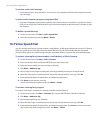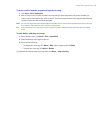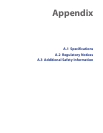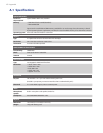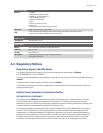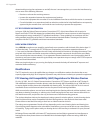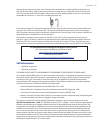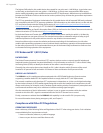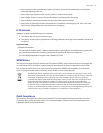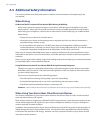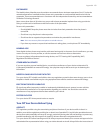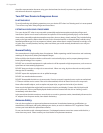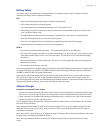
106 Appendix
The highest SAR value for this model device when tested for use at the ear is 1.490 W/kg @ 1g and when worn
on the body, as described in this user guide, is 1.380 W/kg @ 1g. (Body-worn measurements differ among
device models, depending upon available accessories and FCC requirements). While there may be differences
between the SAR levels of various devices and at various positions, they all meet the government requirement
for safe exposure.
The FCC has granted an Equipment Authorization for this model device with all reported SAR levels evaluated
as in compliance with the FCC RF exposure guidelines. SAR information on this model device is on file with the
FCC and can be found under the Display Grant section of https://gullfoss2.fcc.gov/prod/oet/cf/eas/reports/
GenericSearch.cfm after searching on FCC ID: NM8LIBR100.
Additional information on Specific Absorption Rates (SAR) can be found on the Cellular Telecommunications &
Internet Association (CTIA) web-site as http://www.phonefacts.net.
* In the United States and Canada, the SAR limit for mobile CDMA phone used by the public is 1.6 Watts/kg
(W/kg) averaged over one gram of tissue. The standard incorporates a substantial margin of safety to give
additional protection for the public and to account for any variations in measurements.
Normal condition only to ensure the radiative performance and safety of the interference. As with other
mobile radio transmitting equipment, users are advised that for satisfactory operation of the equipment and
for the safety of personnel, it is recommended that no part of the human body be allowed to come too close
to the antenna during operation of the equipment.
FCC Enhanced 911 (E911) Rules
BACKGROUND
The Federal Communications Commission (FCC) requires wireless carriers to transmit specific latitude and
longitude location (Automatic Location Identification = ALI) information as well as “911” calls to Public Safety
Answering Points (PSAPs) to identify the location of the caller in case of emergency.
Generally, the rules require that carriers identify an E911 caller’s location within 50 meters of the actual
location for 67 percent of calls and within 150 meters of the actual location for 95 percent of calls.
LIBR100’s ALI CAPABILITY
The LIBR100 is an ALI-capable smartphone equipped with a GPS (Global Positioning System) receiver
supporting a satellite-based GPS ALI-capable network to comply with the FCC’s ALI requirements.
The network compliance with the above FCC requirements is dependent on: (a) the use of digital technology
by the wireless network; (b) GPS satellite signals being able to reach the handset (such transmissions do not
always work indoors, for example) ; and (c) handset signals reaching wireless “base stations” (atmospheric and
environmental conditions may cause variations in handset receiving signal strength).
Also the transmission of the ALI information is subject, in part, to system constraints within the wireless
network to which the E911 signal is transmitted and over which UT Starcom has no control.
Finally, customers are advised that the LIBR100’s ALI capability is to be used for E911 purposes only.
For more information about placing emergency calls, see Chapter 2.
Compliance with Other FCC Regulations
OPERATING PROCEDURES
Never violate any of the following Rules and Regulations of the FCC when using your device. Such violations
are punishable by fine, imprisonment or both.
• Never use obscene, indecent, or profane language.
• Never use your device to send false distress calls.



